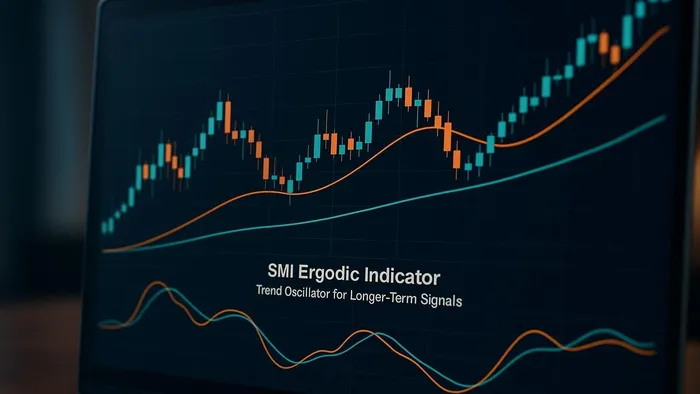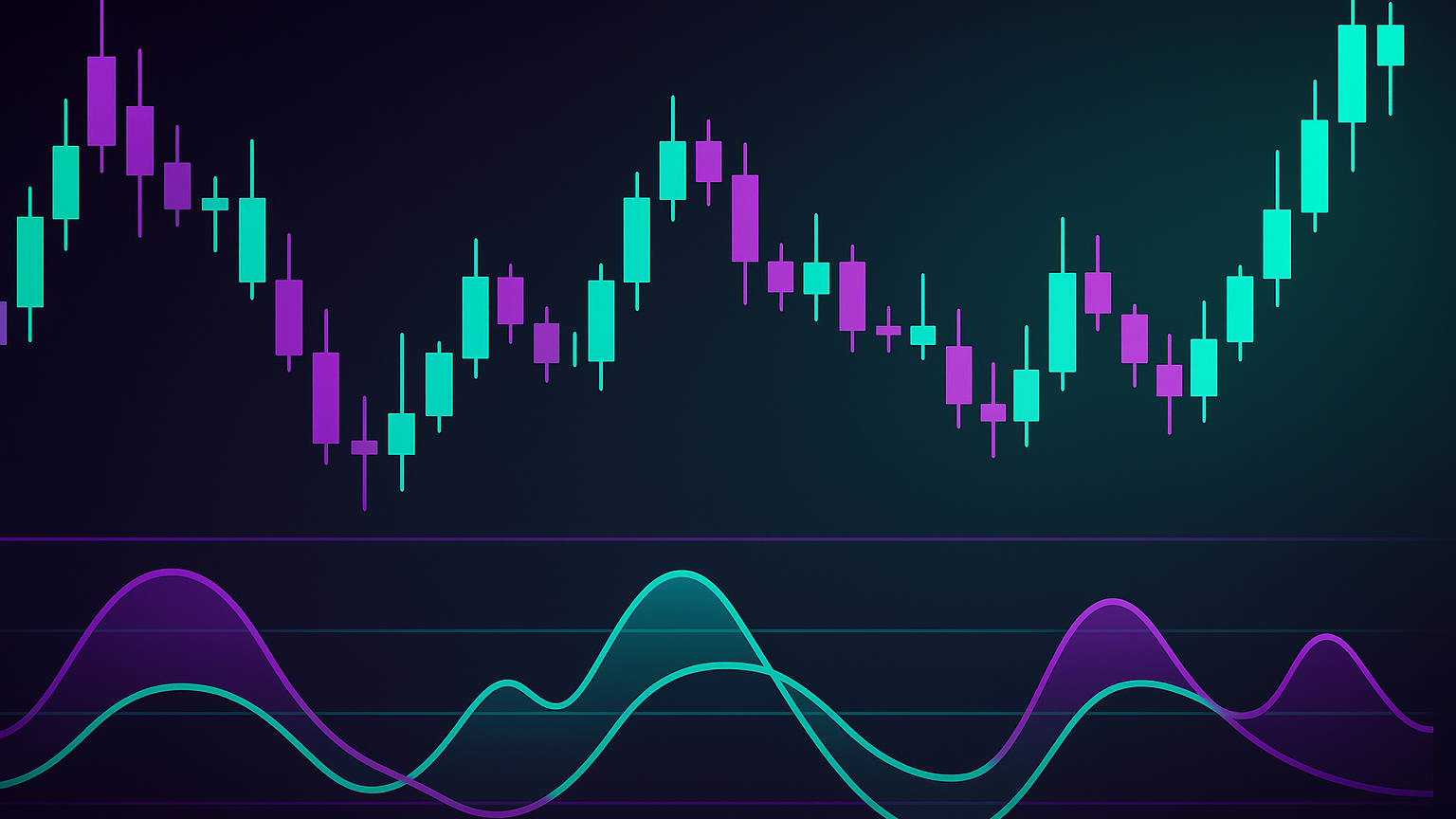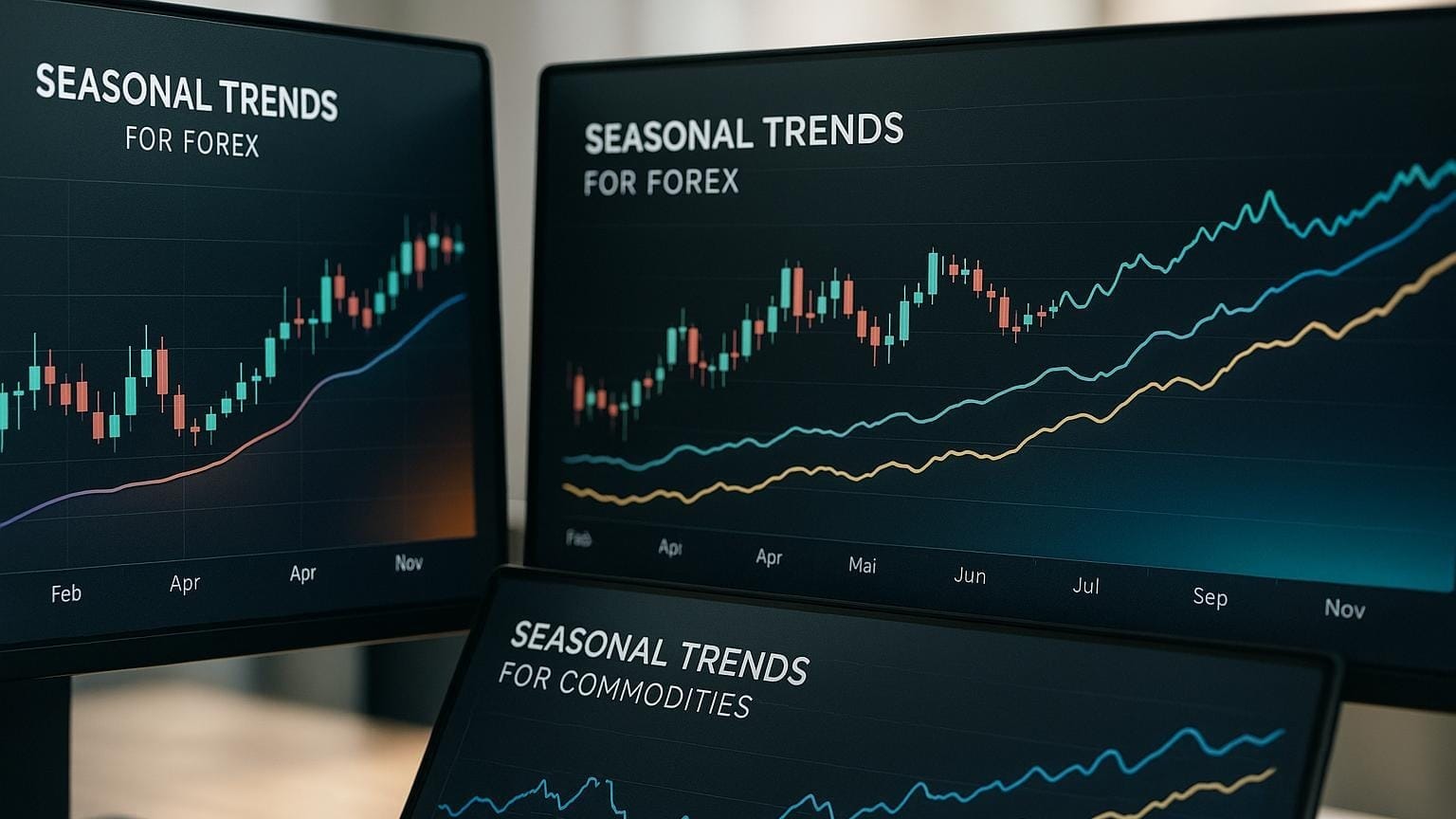Explore the SMI Ergodic Indicator, a momentum oscillator that identifies long-term trends while minimizing market noise for effective trading strategies.
The SMI Ergodic Indicator is a momentum oscillator designed to identify long-term trends while reducing market noise. It combines the Stochastic Momentum Index (SMI) and the True Strength Index (TSI), offering smoother and more reliable signals. Key components include the SMI line (tracks price momentum), the signal line (filters noise), and the histogram (shows momentum strength and direction).
Key Highlights:
- Purpose: Detect sustained momentum changes and trend strength.
- How It Works: Uses a dual smoothing process to minimize false signals (see exponential moving averages for background).
- Signals:
- Positive histogram = bullish momentum.
- Negative histogram = bearish momentum.
- Crossovers between the SMI and signal lines indicate potential entry/exit points.
- Best Use Cases:
- Swing and position trading (intro to swing trading).
- Analyzing U.S. equities, ETFs, forex, and cryptocurrencies.
Important: The SMI Ergodic Indicator is not part of LuxAlgo’s toolkits. It’s a separate indicator you can use alongside LuxAlgo resources on TradingView for confirmation and context.
Pairing this indicator with resources like moving averages, volume analysis, and trend confirmation methods improves reliability. While it excels at identifying trends, it may lag during rapid reversals or struggle in sideways markets. Testing and refining settings for specific assets and timeframes can enhance its effectiveness.
How to Use the SMI Ergodic Oscillator Successfully
How the SMI Ergodic Indicator Is Built and Calculated
Getting a handle on how the SMI Ergodic Indicator works can help traders make smarter decisions about its use. Created by William Blau and rooted in the True Strength Index (TSI) [1], this indicator relies on a two-step smoothing process to provide clearer momentum insights.
Instead of relying on raw and often erratic price data, the SMI Ergodic Indicator applies two exponential moving averages (EMAs). This approach reduces market noise and smooths out short-term price swings, offering a cleaner momentum reading (see EMA basics).
Main Parts: SMI Line, Signal Line, and Histogram
The SMI Ergodic Indicator has three key components, each playing a unique role in analyzing market momentum:
| Component | Description | Primary Function | Visual Appearance |
|---|---|---|---|
| SMI Line | Represents closing price momentum based on the TSI. | Tracks momentum relative to recent price ranges. | Oscillates around a zero line. |
| Signal Line | A smoothed version of the SMI Line using an EMA. | Filters out minor price fluctuations. | A smoother line following the SMI Line. |
| Histogram | The difference between the SMI Line and the Signal Line. | Highlights momentum strength and directional shifts. | Bars above or below zero. |
The SMI Line measures momentum by comparing price changes to the recent price range. When it crosses above zero, it signals increasing upward momentum; when it drops below zero, it indicates growing downward momentum.
The Signal Line, created by smoothing the SMI Line, reduces noise and focuses on more meaningful momentum shifts. Finally, the Histogram visually represents the difference between the two lines, with positive bars showing bullish momentum and negative bars indicating bearish momentum. The height of these bars reflects the strength of the trend at any given time.
Step-by-Step Calculation Process
The SMI Ergodic Indicator is calculated in three main steps:
1. Calculate the SMI (True Strength Index):
The formula for the SMI is:
SMI = (PCDS / APCDS) × 100
- PCDS (Price Close Double Smoothed) and APCDS (Absolute Price Close Double Smoothed) are calculated by taking the difference between today's and yesterday's closing prices, then applying separate EMAs to both the price changes and their absolute values.
- This double smoothing process creates a ratio that oscillates around zero, typically ranging between -100 and +100. For background on TSI, see TSI overview.
2. Create the Signal Line:
The Signal Line is derived by applying an EMA to the SMI value:
Signal Line = EMA(TSI, signal period)
- Most platforms use a 5-period EMA by default, but traders can customize this setting to adjust the indicator's sensitivity.
3. Generate the Histogram:
The Histogram is calculated by subtracting the Signal Line from the SMI Line:
Histogram = SMI Line - Signal Line
- For instance, if the SMI Line is +15.50 and the Signal Line is +12.25, the Histogram will show a value of +3.25, signaling strengthening bullish momentum.
Each step in this process reduces market noise, providing traders with more dependable signals for identifying longer-term trends. The default settings — 20 periods for the SMI Line and 5 periods for the Signal Line — balance responsiveness with stability, making the indicator versatile for different trading strategies.
How to Read SMI Ergodic Indicator Signals
To make the most of the SMI Ergodic Indicator, focus on how the histogram highlights market momentum. By examining the histogram's extreme values, you can identify potential turning points in momentum and gauge when price movements may be overextended.
Reading Momentum and Signal Crossovers
Signal line crossovers are key for identifying trade opportunities. When the SMI line crosses above the signal line, it suggests an increase in upward momentum, signaling a potential bullish move. On the other hand, when the SMI line dips below the signal line, it indicates growing downward momentum, signaling a bearish trend.
The histogram simplifies spotting these crossovers. A shift from negative to positive on the histogram confirms a bullish crossover, while a move from positive to negative validates a bearish one. The strength of these signals often depends on their position relative to the zero line and recent price trends.
Spotting Overbought and Oversold Levels
Overbought levels are identified when the histogram hits unusually high positive values compared to recent trading activity [3] [1]. Similarly, oversold conditions emerge when the histogram plunges to unusually low negative values relative to recent price action [1]. For a broader primer, see overbought/oversold indicators.
To spot these extremes, look for "outlier" values — levels the histogram hasn’t reached in a while. For daily charts, focus on levels not seen in the past 20–30 trading days. For weekly charts, check for extremes absent in the last 10–15 weeks.
Outlier positive values suggest overbought conditions, signaling a chance to take profits [1].
Outlier negative values point to oversold conditions, presenting an opportunity to cover short positions [1].
While extreme values hint at potential reversals, they don’t guarantee immediate changes. Use the histogram’s visual clues — tall positive bars for overbought conditions and deep negative bars for oversold conditions — as a guide to market momentum. Always confirm these signals with other technical resources before acting.
Trading Strategies and Tool Integration
The SMI Ergodic Indicator delivers its best results when paired with other technical analysis resources rather than being used on its own. No single indicator can provide the full picture, so creating a robust trading system means blending it strategically with complementary methods. This approach builds on the indicator’s smoothing and momentum features, improving its overall dependability.
Combining SMI Ergodic with Other Trading Tools
At its core, price action analysis is essential for any SMI Ergodic strategy. For instance, when the histogram shows extreme overbought conditions, you can confirm this by identifying key resistance levels, bearish candlestick patterns, or signs of volume divergence. On the other hand, in extreme oversold conditions, look for support levels and bullish reversal patterns to validate the signal.
Trend confirmation resources can significantly boost the reliability of SMI Ergodic signals. For example, Oscillator Matrix provides real-time divergence detection and insights into money flow, which complement the momentum readings of the SMI Ergodic. Again, the SMI Ergodic Indicator itself is not included in LuxAlgo’s toolkits — it’s used alongside these resources for confirmation.
Moving averages add another layer of confirmation, particularly for longer-term trends. For example, using the 50-day and 200-day moving averages can help determine the overall trend direction. Bullish crossovers in the SMI Ergodic Indicator are more meaningful when prices are trading above these moving averages, while bearish crossovers carry more weight when prices are below them.
Volume analysis further validates momentum shifts detected by the SMI Ergodic. High volume during histogram extremes often confirms reliable reversals. Conversely, weak volume during such extremes may indicate that the momentum change lacks conviction.
By layering multiple confirmations — such as combining the SMI Ergodic’s momentum readings with trend analysis, support and resistance levels, and volume patterns — you can create a more balanced and reliable trading approach.
Testing and Validating Your Trading Strategies
Once you’ve built an SMI Ergodic-based strategy, testing it thoroughly is critical to ensure its effectiveness before putting real money on the line. Backtesting is an essential step, as it allows you to analyze how your strategy would have performed in past market conditions (backtesting vs. forward testing overview). Skipping this step is akin to trading blindly, without a solid plan.
Experiment with different EMA settings to find the right balance between signal frequency and accuracy [1][2]. While the standard SMI Ergodic parameters work well in many scenarios, market variations may require adjustments to suit specific conditions.
Multiple timeframe testing helps identify which timeframes align best with your trading style. For instance, swing traders often see better results on daily and 4-hour charts, while day traders may focus on intraday timeframes [1]. Through backtesting, you can also fine-tune risk management parameters, such as stop-loss levels and position sizing, to match your risk tolerance [1].
Incorporating machine learning into backtesting can take your strategy to the next level. Studies show that using machine learning with the SMI Ergodic Indicator has improved prediction accuracy by 23% compared to traditional methods [2]. LuxAlgo’s AI Backtesting Assistant offers personalized parameter recommendations and real-time optimization across multiple timeframes and assets; consult the documentation and strategy-fetching guide for details. This platform does not include the SMI Ergodic Indicator; it can be used in conjunction with it for research and validation.
After backtesting, it’s important to continually tweak your strategy to keep up with changing market conditions. Regular adjustments to indicator settings can help your system remain effective during periods of high volatility or when markets shift from trending to range-bound behavior [2].
Automated backtesting across multiple timeframes offers a broader perspective on strategy performance. This method, especially when combined with machine learning, enables you to test hundreds of parameter combinations quickly, uncovering optimal settings far more efficiently than manual testing [2].
While backtesting provides valuable insights, remember that it relies on historical data, which doesn’t guarantee future success. However, strategies that consistently perform well across various market conditions and timeframes are generally more dependable than those tested on limited datasets. You can also explore recent AI backtesting improvements for additional context.
Pros and Cons of the SMI Ergodic Indicator
The SMI Ergodic Indicator, like any resource in technical analysis, comes with its own set of strengths and weaknesses. Knowing these can help you decide when and how to use it effectively in your trading strategy.
Benefits vs Drawbacks Comparison
This indicator offers several advantages, but it also has limitations that traders need to consider. By weighing both, you can set realistic expectations and make better trading decisions.
| Benefits | Drawbacks |
|---|---|
| Smooth Signal Generation: Its double smoothing process reduces market noise, offering cleaner signals compared to simpler oscillators. | Lagging Nature: The smoothing can delay signals, causing missed opportunities during quick trend reversals or early trend changes. |
| Clear Momentum Visualization: The histogram format makes it easy to identify momentum shifts and gauge trend strength visually. | False Signals in Choppy Markets: Struggles in sideways or range-bound markets, often generating misleading crossovers. |
| Effective Divergence Detection: Excels at spotting momentum divergences, which often signal potential price reversals. | Requires Confirmation: It’s not a standalone indicator and benefits from complementary confirmation. |
| Focus on Longer-Term Trends: Better suited for identifying sustained trends rather than short-term price movements. | Limited Scalping Applications: Not ideal for very short timeframes or high-frequency trading strategies. |
| Overbought/Oversold Clarity: Clearly marks extreme levels, helping traders pinpoint potential reversal zones. | Parameter Sensitivity: Results can vary significantly based on EMA settings, requiring careful optimization for different markets. |
While these challenges exist, they can be addressed with thoughtful adjustments.
Overcoming the Limitations
To work around the indicator’s drawbacks, consider pairing it with complementary resources. For example, faster oscillators can help you catch early signals that the SMI Ergodic might miss. Use the indicator on higher timeframes to identify overall trends and switch to lower timeframes for more precise trade entries.
In choppy market conditions, reduce your position size or avoid trades entirely when the histogram frequently crosses around the zero line. This simple step can help you avoid many false signals during consolidation phases.
Volume analysis can also add value. When the histogram shows extremes, strong volume can confirm the validity of the signal, while weak volume may indicate a lack of conviction. A deeper dive into volume methods is available in our volume indicators guide.
Optimizing backtests and adjusting strategy rules are key steps. Test different settings systematically to find combinations that work best for the market you’re trading.
Finally, always use strong risk management practices. Set clear stop-loss levels and position sizes to protect yourself from occasional false signals. For a more comprehensive approach, consider integrating the SMI Ergodic with tools like divergence detection or price action automation. These can provide the additional confirmation needed to enhance your trading strategy.
Conclusion
The SMI Ergodic Indicator stands out for identifying longer-term trends in financial markets. By using a double-smoothed calculation, it minimizes market noise and delivers clear signals through momentum crossovers, divergence patterns, and overbought or oversold levels. This makes it particularly effective at capturing sustained trend movements.
However, understanding both its strengths and limitations is crucial. While the indicator's inherent lag helps filter out false signals, it also means it may react slower to sudden price changes. Its histogram format simplifies the process of spotting momentum shifts, and its ability to detect divergence can highlight potential reversals before they are evident in price action.
To maximize its utility, consider pairing the SMI Ergodic Indicator with complementary resources. Combining it with volume analysis, faster oscillators, or trend-following indicators can provide a more comprehensive trading approach. This multi-resource approach can help confirm signals and reduce reliance on a single indicator.
For traders seeking an edge, LuxAlgo provides resources such as screeners, alerts, and AI backtesting updates to streamline strategy development. You can also try AI Backtesting directly and review the documentation for best practices. These offerings do not include the SMI Ergodic Indicator; they are complementary and can be used alongside it.
In practice, use the SMI Ergodic Indicator on higher timeframes to determine the overall trend, and switch to shorter timeframes for fine-tuning entry points. Always back your strategy with strict position sizing and stop-loss measures — no indicator can replace the importance of sound risk management.
FAQs
What makes the SMI Ergodic Indicator unique, and why is it ideal for analyzing longer-term trends?
The SMI Ergodic Indicator is distinct from other momentum oscillators because of its sharper sensitivity to price changes and its capability to cut through market noise. This refined design helps traders avoid false signals, providing a clearer picture of genuine market momentum.
While tools like the MACD or stochastic oscillator are widely used, the SMI Ergodic Indicator is better suited for spotting longer-term trends and potential reversals. Its wider value range and smoother operation make it an excellent choice for traders aiming to analyze sustained market movements rather than focusing on short-term shifts.
How can traders effectively use the SMI Ergodic Indicator alongside other tools to enhance trading accuracy?
To boost trading precision, consider combining the SMI Ergodic Indicator with other methods that complement its strengths. For instance, pairing it with trend-following indicators like moving averages can help confirm both the market’s direction and its strength. Adding oscillators such as the RSI or MACD provides another layer of validation for momentum signals, helping to filter out false reversals.
You can also enhance your strategy by incorporating price action analysis, such as pinpointing critical support and resistance levels. This approach can sharpen your entry and exit points. By integrating these elements into a well-thought-out trading plan, you create a system that cross-verifies trends using multiple indicators, minimizing the chances of acting on unreliable signals.
How can traders adjust the SMI Ergodic Indicator to perform better across different markets and asset types?
To get the most out of the SMI Ergodic Indicator, it's crucial to tweak its settings to match the market conditions and the asset you're trading. For fast-moving markets like stocks or forex, shorter time periods (around 5–10) can make the indicator react more quickly to price changes. On the other hand, for more stable assets like commodities or indices, longer time periods (14–20) work better, as they help smooth out the noise and provide clearer signals.
You can also adjust the overbought and oversold thresholds to refine the indicator's accuracy. In markets with strong trends, widening these thresholds can help filter out false signals, making it easier to spot real momentum changes. Testing and adjusting these settings allows you to tailor the indicator to fit your trading strategy and the specific market environment you're working in.
References
LuxAlgo Resources
- Adaptive Momentum Oscillator
- Understanding Moving Averages and How Traders Use Them
- Volumetric Toolkit
- AI Backtesting: Fetching Strategies
- Price Action Concepts™
- Reversal Candlestick Structure
- Support & Resistance Dynamic
- Oscillator Matrix
- Nadaraya–Watson Smoothers
- Pivot-Based Trailing Maxima/Minima
- New AI Backtesting Features for Smarter Trading
- AI Backtesting Assistant
- AI Backtesting Assistant Documentation
- Backtesting vs. Forward Testing
- Strategy Scripting (Backtesters)
External Resources
- Stochastic Momentum Index (Wealth-Lab)
- True Strength Index (Wikipedia)
- SMI Ergodic Overview (TrendSpider)
- Ergodic Oscillator (Quantified Strategies)
- What Is the SMI Ergodic Indicator? (Gate Learn)
- Exponential Moving Average (Investopedia)
- Introduction to Swing Trading (Investopedia)
- Overbought/Oversold Indicators (Investopedia)
- True Strength Index (StockCharts ChartSchool)








